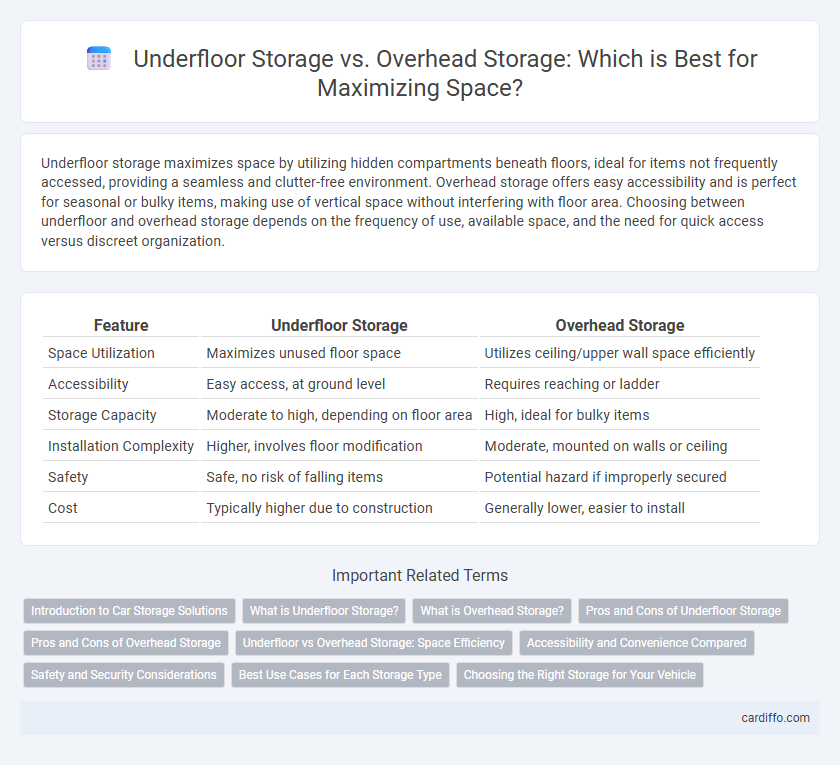Underfloor storage maximizes space by utilizing hidden compartments beneath floors, ideal for items not frequently accessed, providing a seamless and clutter-free environment. Overhead storage offers easy accessibility and is perfect for seasonal or bulky items, making use of vertical space without interfering with floor area. Choosing between underfloor and overhead storage depends on the frequency of use, available space, and the need for quick access versus discreet organization.
Table of Comparison
| Feature | Underfloor Storage | Overhead Storage |
|---|---|---|
| Space Utilization | Maximizes unused floor space | Utilizes ceiling/upper wall space efficiently |
| Accessibility | Easy access, at ground level | Requires reaching or ladder |
| Storage Capacity | Moderate to high, depending on floor area | High, ideal for bulky items |
| Installation Complexity | Higher, involves floor modification | Moderate, mounted on walls or ceiling |
| Safety | Safe, no risk of falling items | Potential hazard if improperly secured |
| Cost | Typically higher due to construction | Generally lower, easier to install |
Introduction to Car Storage Solutions
Underfloor storage systems maximize space by utilizing the area beneath the vehicle floor, providing secure, hidden compartments ideal for tools or emergency supplies. Overhead storage solutions, such as ceiling-mounted racks or cabinets in garages, optimize vertical space to store larger items like car parts, seasonal tires, or bulky equipment. Both storage types enhance organization and accessibility, catering to different needs in efficient car storage management.
What is Underfloor Storage?
Underfloor storage refers to a built-in storage solution integrated beneath floor surfaces, maximizing space utilization in residential or commercial settings. It offers concealed compartments ideal for storing items like seasonal decorations, tools, or emergency supplies, providing easy access without cluttering living areas. This method enhances room aesthetics and can improve organization by utilizing otherwise wasted space efficiently.
What is Overhead Storage?
Overhead storage refers to storage solutions installed above head height, such as ceiling-mounted racks, shelves, or cabinets designed to maximize vertical space in garages, warehouses, or rooms with limited floor area. These systems allow for efficient organization of rarely used items or bulky equipment, freeing up valuable floor space and improving accessibility. Overhead storage often supports heavy-duty capacity and can be customized to fit specific spatial dimensions, enhancing storage optimization in both residential and commercial environments.
Pros and Cons of Underfloor Storage
Underfloor storage maximizes unused space by utilizing the floor area beneath, reducing clutter and increasing room efficiency without compromising floor layout. However, it may require specialized construction, limiting accessibility and increasing installation costs. Moisture buildup and ventilation challenges can also impact the longevity and safety of stored items.
Pros and Cons of Overhead Storage
Overhead storage maximizes vertical space utilization by freeing up floor areas, making it ideal for garages and workshops with limited square footage. It offers easy accessibility for infrequently used items and can reduce clutter, but it may pose safety risks if not properly installed or overloaded. Limited load capacity and potential difficulty in accessing heavy objects are notable drawbacks compared to underfloor storage options.
Underfloor vs Overhead Storage: Space Efficiency
Underfloor storage maximizes space efficiency by utilizing otherwise unused floor cavities, offering a discreet and accessible solution without compromising room layout. Overhead storage optimizes vertical space, ideal for storing bulky or seasonal items, but may require ladders and reduce ceiling height clearance. Combining both methods provides comprehensive storage options that enhance organization while preserving valuable living and working areas.
Accessibility and Convenience Compared
Underfloor storage offers seamless accessibility by keeping items at ground level, reducing the need for climbing or reaching, which enhances convenience for frequently used goods. Overhead storage maximizes space utilization but often requires ladders or step stools, making access less immediate and potentially inconvenient for everyday items. Choosing between these options depends largely on balancing ease of access with space efficiency in storage planning.
Safety and Security Considerations
Underfloor storage offers enhanced safety by minimizing trip hazards and reducing the risk of falling objects, which is crucial in high-traffic areas. Overhead storage requires secure mounting systems and regular inspections to prevent accidents from falling items, making it essential to use sturdy brackets and anchor points. Both options must incorporate adequate locking mechanisms and be resistant to environmental factors to ensure the security of stored goods.
Best Use Cases for Each Storage Type
Underfloor storage maximizes space efficiency by utilizing unused floor cavities, ideal for seasonal items, rarely accessed belongings, and heavy objects that benefit from ground-level placement. Overhead storage is best suited for lightweight, infrequently used items like holiday decorations or camping gear, keeping floors clear and making use of ceiling or high wall space in garages and workshops. Choosing the right type depends on item weight, access frequency, and available room dimensions, optimizing storage capacity and ease of access.
Choosing the Right Storage for Your Vehicle
Underfloor storage offers a discreet and secure solution for vehicles, ideal for storing tools and emergency equipment without sacrificing cabin space. Overhead storage maximizes interior volume by utilizing ceiling space, perfect for lightweight items and frequently accessed gear. Selecting the right storage depends on vehicle type, storage capacity needs, and ease of access preferences to optimize space efficiency and safety.
Underfloor Storage vs Overhead Storage Infographic

 cardiffo.com
cardiffo.com